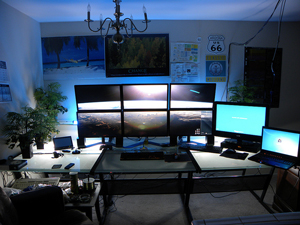
Source: Neon Internet Cafe open 24 hours, Justinc, Wikimedia
When you want to present a shortened and straightforward account of the facts in an article, you summarize. When you want to discuss opinions, make judgments, agree or disagree with points presented, you critique.
Critiques actually include summarizing, but they also share your ideas and opinions. Those ideas and opinions should be supported by evidence from the text. A writer of a critique should not rely on rumors or any other unsubstantiated information. A good critique shows knowledge and understanding of a subject.
Reread the article about teens, television, and the Internet by opening a PDF of “Teens Tune out TV, Log on Instead.”
Next, read the critique of this article. Keep in mind that critiques can represent varying perspectives. The author of this critique expresses a positive response to Jane Weaver’s article. It’s possible that someone else might write a critique that comes from a negative point of view.
Jane Weaver’s article “Teens Tune out TV, Log on Instead: Young People Spend an Average of 16.7 Hours Online a Week” looks at how today’s young people are reshaping the media landscape. In my opinion, this article does a splendid job of pointing out that teenagers have moved beyond television as the source of their media consumption. Jane Weaver points out that multiple studies conducted by reputable research firms conclude that the average teenager spends many more hours online than he or she does watching television, talking on the phone, listening to the radio, or reading books and magazines.
Weaver states that “young people, ages 13–24, spend an average of 16.7 hours a week online, excluding e-mail, compared to 13.6 hours watching TV.” The report Weaver cites also found that young people spend more time online than listening to radio, talking on the phone, or reading books and magazines for personal pleasure. Some may see this as a problem, but in my opinion, today’s teenagers will most likely need these skills that they develop as consumers of multimedia to be effective in the twenty-first century workforce.
The research referred to in the article, which tracks Internet usage by teenagers, tells us that teens who are surfing the Internet are developing critical job skills like keyboarding and multitasking. Let’s face it: regular old television is a thing of the past, and this article and the studies represented in it are proof of that. The advertising and marketing companies represented in the article are wise in their efforts to track the Internet usage pattern of teens as they represent the future.
Some may respond negatively to Weaver's assertions that teens' lives are permeated by media throughout their waking hours or that they live “multimedia” lives. Let’s not get started down the path that today’s young people are wasting their time online and are losing their ability to focus. This is a tired argument and will not make a difference no matter how often people try to bring it up. As Pew director Lee Rainie states in the article, “the Yahoo! research appears ‘credible’,” meaning that young people are multitasking and consuming a vast array of media at the same time, which helps them develop new talents and contribute to the economy. I say it’s a good thing that they are spending more time online. That is the future they are going to have to live with, so they might as well become experts.

Source: “The Great Monitor Refresh of 2010,” tsilb, Flickr
Let’s look at the first two sentences of the critique highlighted below. The sentence highlighted in blue is accurate in its summary of the article’s main idea. However, the second sentence highlighted in yellow is not quite as precise. The article does not say that teenagers have totally “moved beyond television.” Weaver reports that teens still watch T.V.; they just watch less than they once did. Because this statement does not accurately reflect Weaver’s point of view, it is not credible and contains unsubstantiated information.
Jane Weaver’s article “Teens Tune out TV, Log on Instead: Young People Spend an Average of 16.7 Hours Online a Week” looks at how today’s young people are reshaping the media landscape. In my opinion, this article does a splendid job of pointing out that teenagers have moved beyond television as the source of their media consumption.
It’s your turn to find unsubstantiated opinions in the rest of the critique. Click on a sentence or phrase that you think contains opinions that are not based on what Weaver reported in her article. If you choose correctly, the sentence or phrase will highlight. The unsubstantiated opinion we just discussed is already highlighted for you. You should find three more unsubstantiated opinions. After you find the three instances, go back and place your cursor over each one to see a pop-up discussion.
Jane Weaver’s article “Teens Tune out TV, Log on Instead: Young People Spend an Average of 16.7 Hours Online a Week” looks at how today’s young people are reshaping the media landscape. In my opinion, this article does a splendid job of pointing out that teenagers have moved beyond television as the source of their media consumption. Jane Weaver points out that multiple studies conducted by reputable research firms conclude that the average teenager spends many more hours online than he or she does watching television, talking on the phone, listening to the radio, or reading books and magazines.
Weaver states that “young people, ages 13–24, spend an average of 16.7 hours a week online, excluding e-mail, compared to 13.6 hours watching TV.” The report Weaver cites also found that young people spend more time online than listening to radio, talking on the phone, or reading books and magazines for personal pleasure. Some may see this as a problem, but in my opinion, today’s teenagers will most likely need these skills that they develop as consumers of multimedia to be effective in the twenty-first century workforce.
The research referred to in the article, which tracks Internet usage by teenagers, tells us that teens who are surfing the Internet are developing critical job skills like keyboarding and multitasking. Let’s face it: regular old television is a thing of the past, and this article and the studies represented in it are proof of that. The advertising and marketing companies represented in the article are wise in their efforts to track the Internet usage pattern of teens as they represent the future.
Some may respond negatively to Weaver's assertions that teens' lives are permeated by media throughout their waking hours or that they live “multimedia” lives. Let’s not get started down the path that today’s young people are wasting their time online and are losing their ability to focus. This is a tired argument and will not make a difference no matter how often people try to bring it up. As Pew director Lee Rainie states in the article, “the Yahoo! research appears ‘credible’,” meaning that young people are multitasking and consuming a vast array of media at the same time, which helps them develop new talents and contribute to the economy. I say it’s a good thing that they are spending more time online. That is the future they are going to have to live with, so they might as well become experts.
Let’s review what you have learned about summaries and critiques:
- Summaries are statements of the main points and ideas in a text and do not include anything but accurate information about the original text.
- Critiques are discussions or arguments that analyze and assess a text. A critique permits the writer to share feelings, opinions, and judgments as long as they are backed up by evidence and examples from the original text.
By removing the unsubstantiated opinions in the critique above, you should now have a strong critique. Check your understanding below to see the stronger critique.
Jane Weaver’s article “Teens Tune out TV, Log on Instead: Young People Spend an Average of 16.7 Hours Online a Week” looks at how today’s young people are reshaping the media landscape. Jane Weaver points out that multiple studies conducted by reputable research firms conclude that the average teenager spends many more hours online than he or she does watching television, talking on the phone, listening to the radio, or reading books and magazines.
Weaver states that “young people, ages 13–24, spend an average of 16.7 hours a week online, excluding e-mail, compared to 13.6 hours watching TV.” The report Weaver cites also found that young people spend more time online than listening to radio, talking on the phone, or reading books and magazines for personal pleasure.
The research that Weaver refers to, which tracks Internet usage by teenagers, tells us that teens who are surfing the Internet are developing critical job skills like keyboarding and multitasking. The advertising and marketing companies represented in the article are wise in their efforts to track the Internet usage of teens as these patterns represent the future.
Some may respond negatively to Weaver's assertions that teens’ lives are permeated by media throughout their waking hours or that they live “multimedia” lives.As Pew director Lee Rainie states in the article, “the Yahoo! research appears ‘credible,’ ” meaning that young people are multitasking and consuming a vast array of media at the same time, which helps them develop new talents and contribute to the economy. I say it’s a good thing that they are spending more time online. That is the future they are going to have to live with, so they might as well become experts.